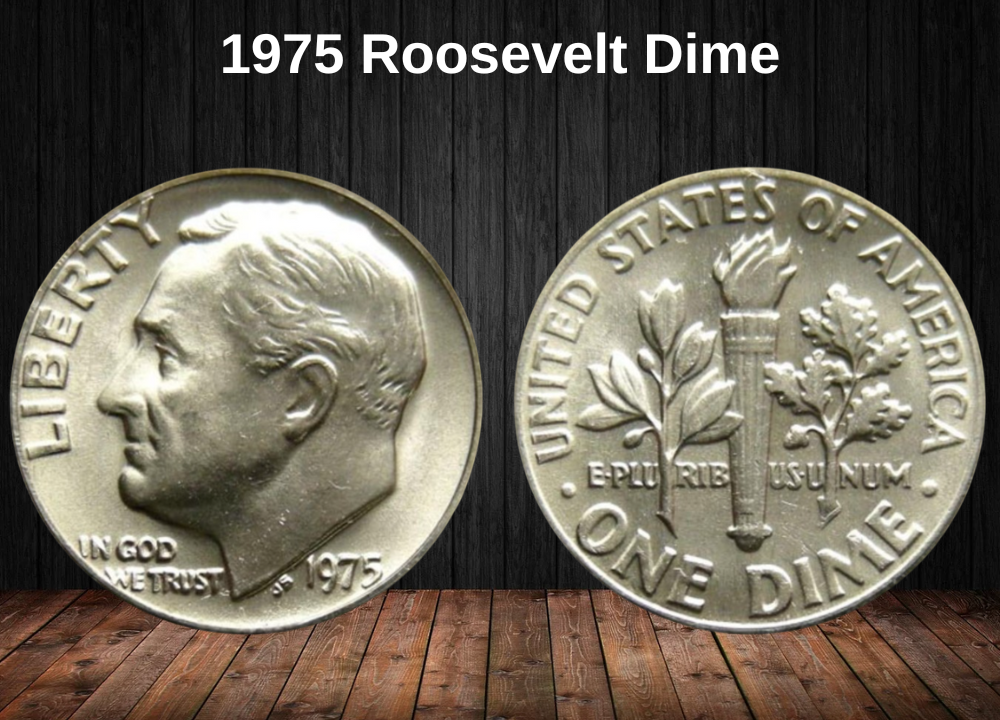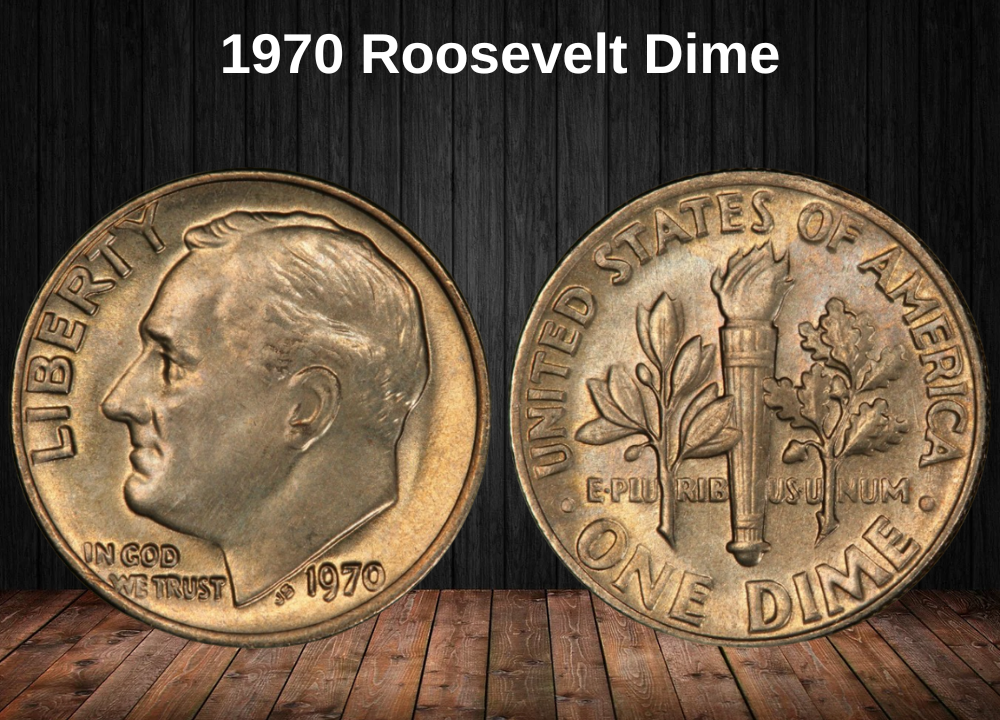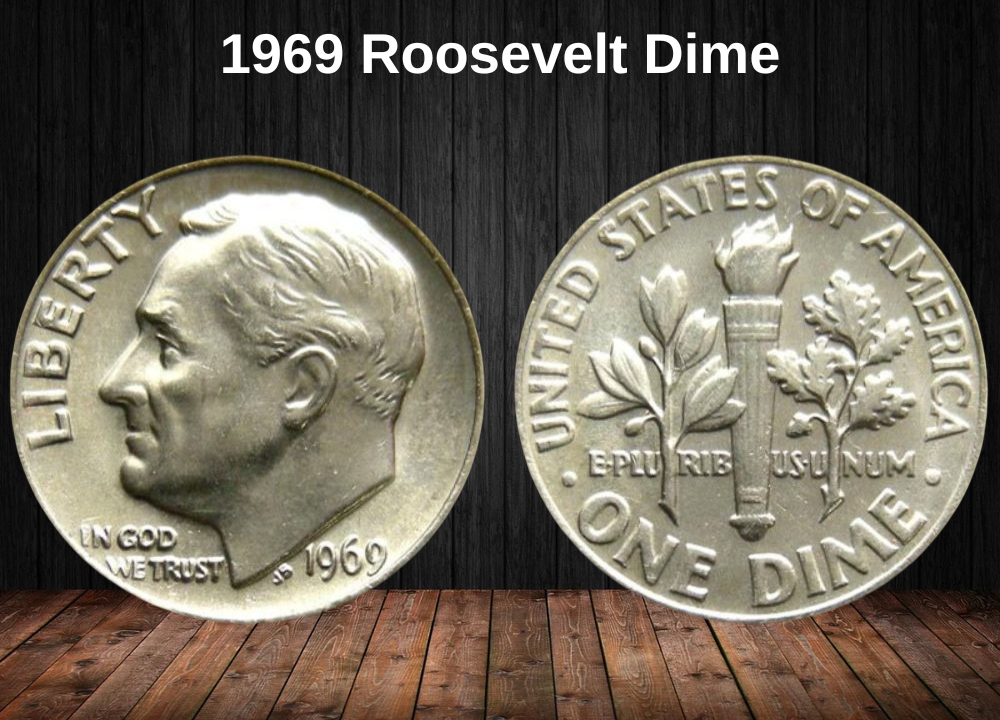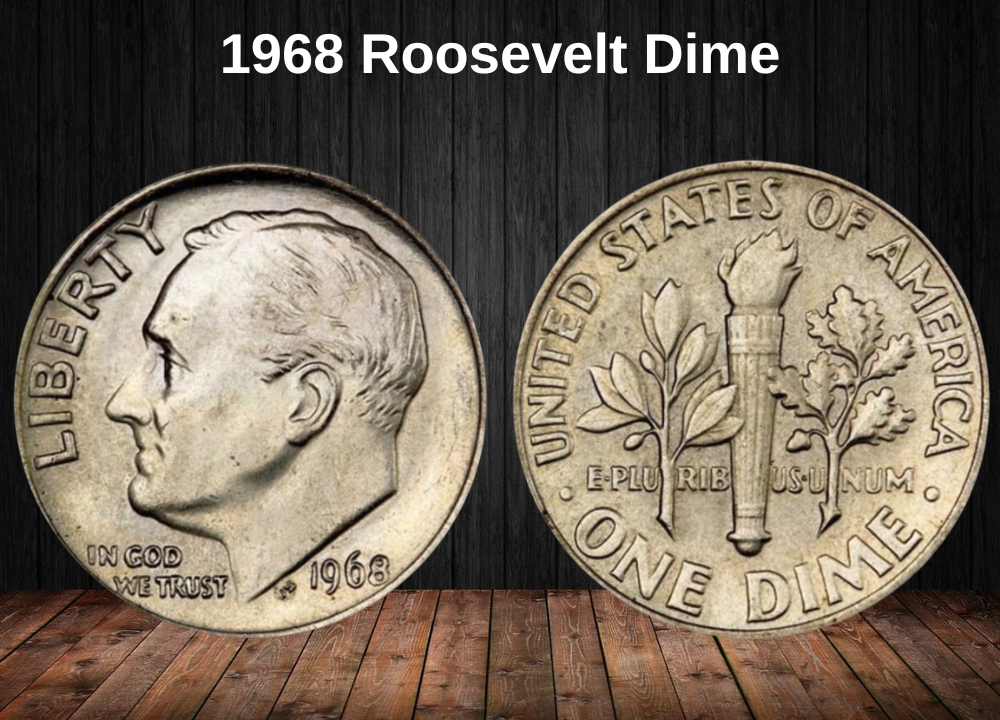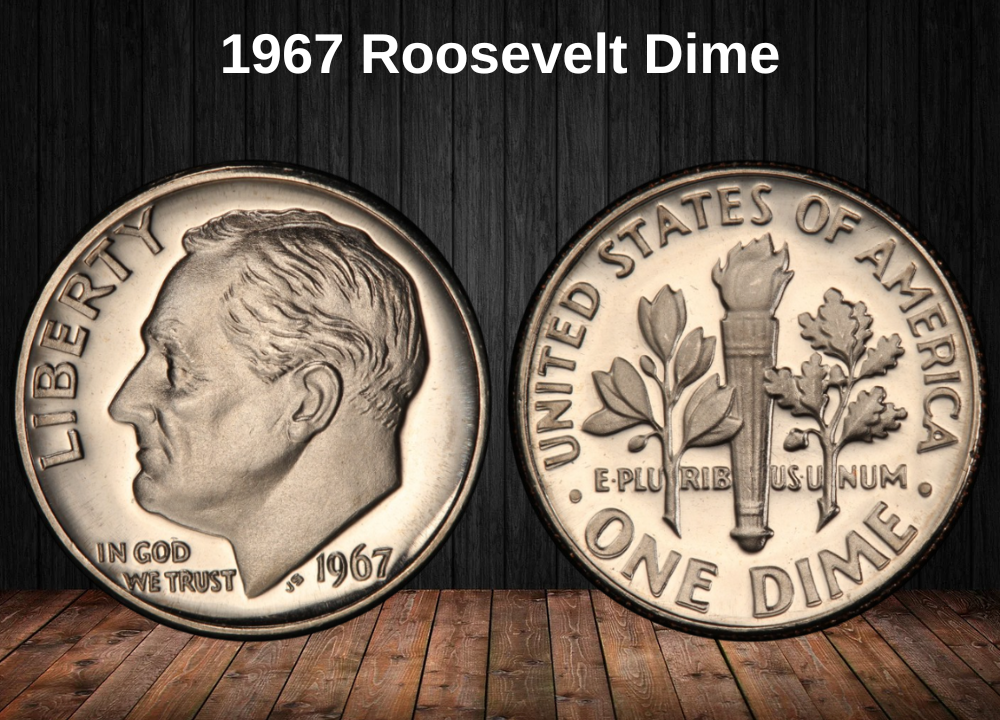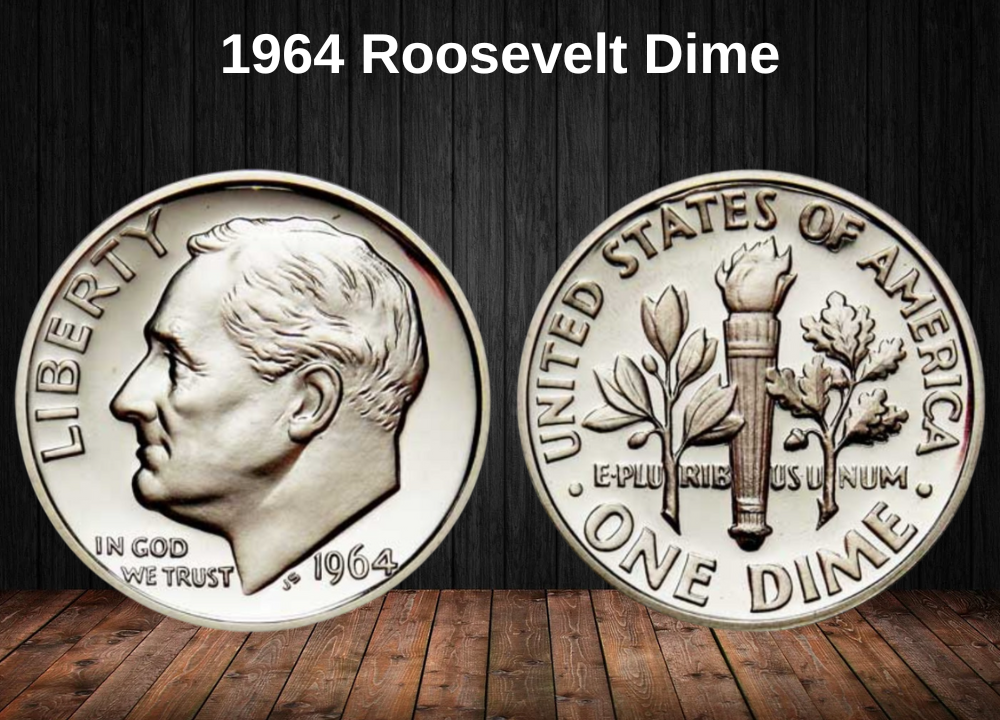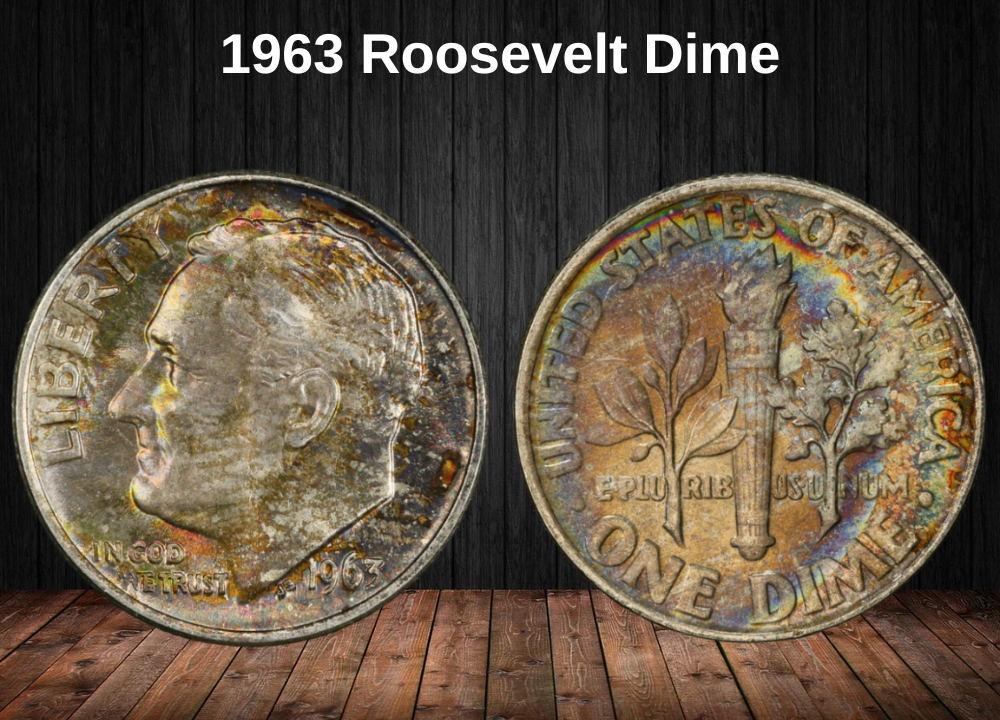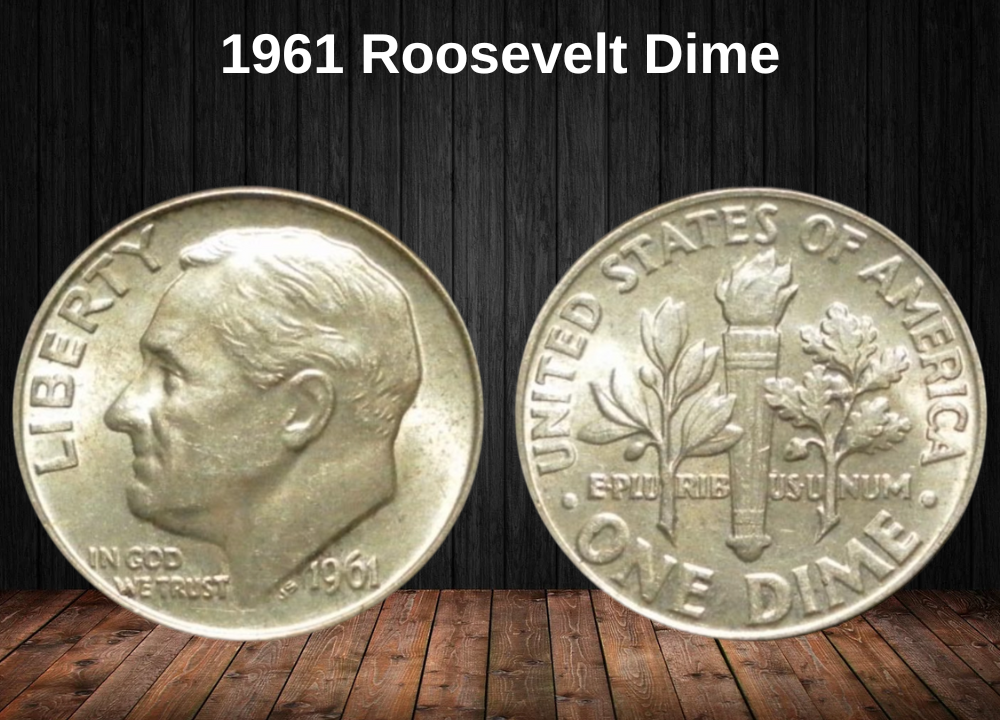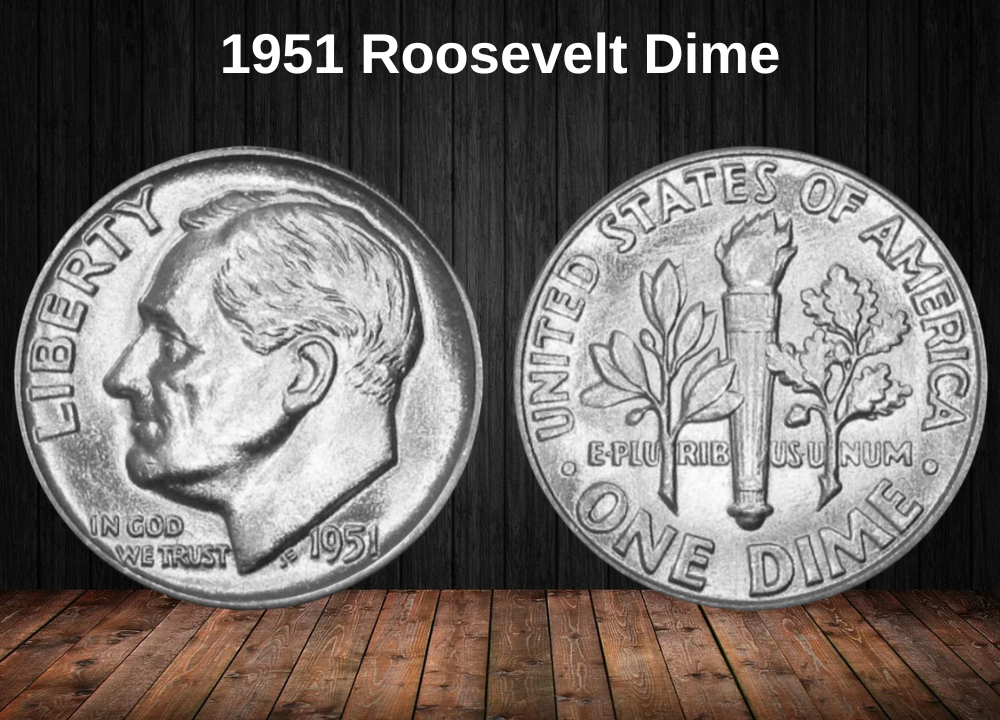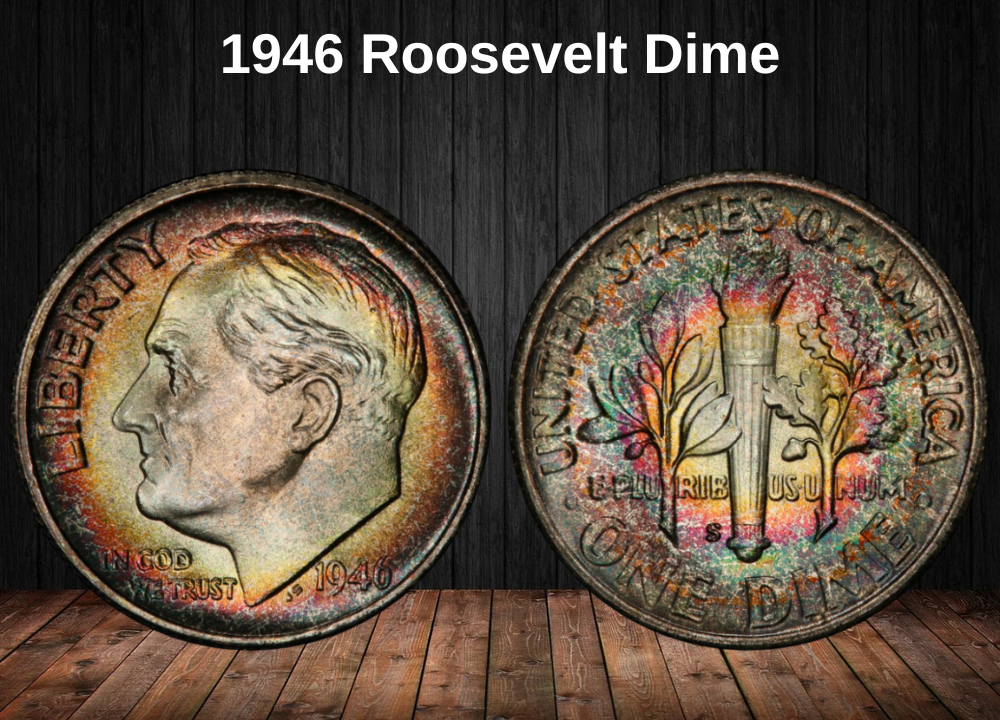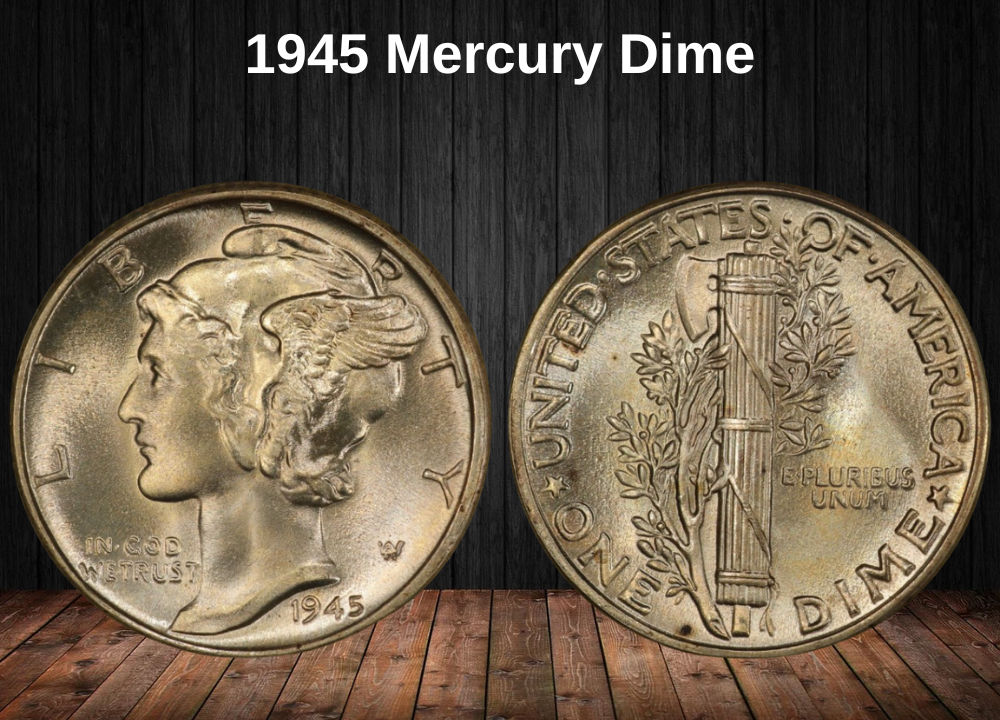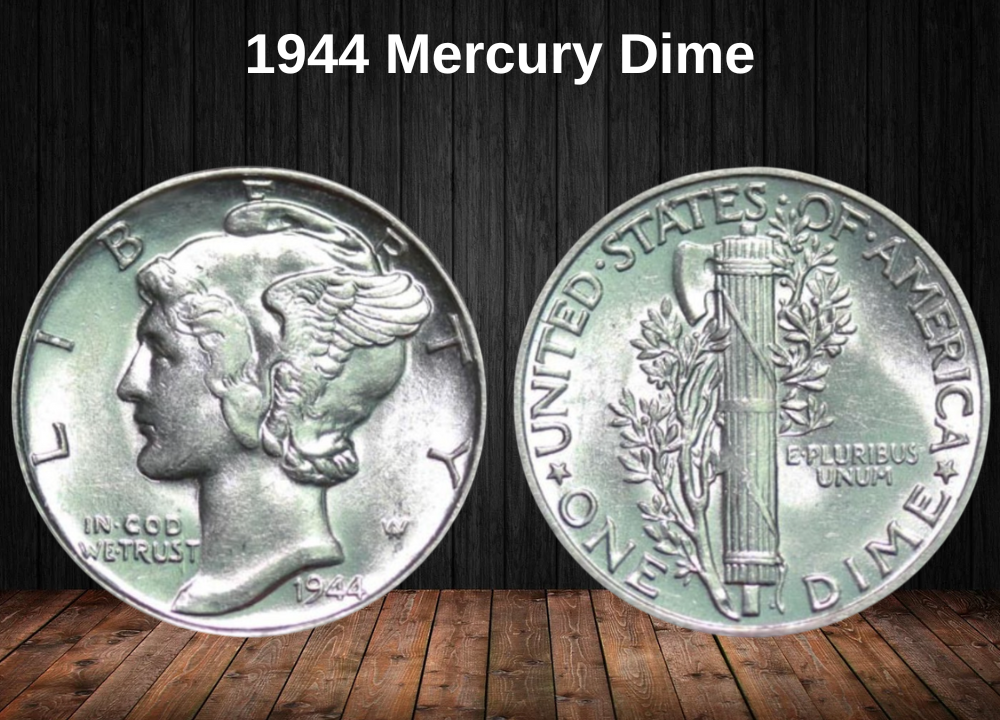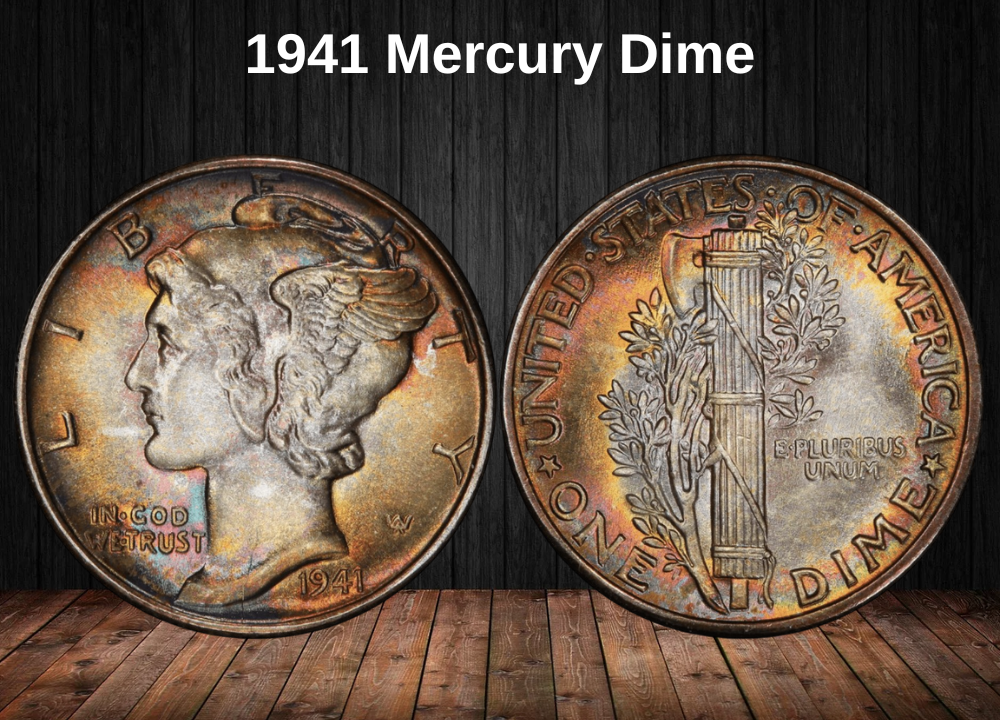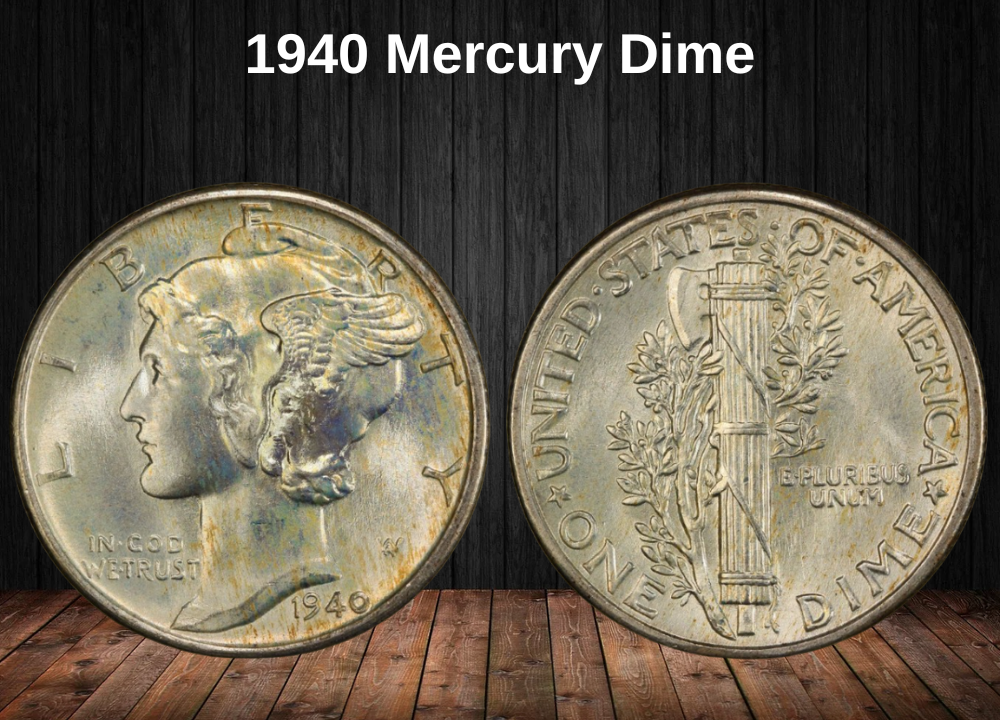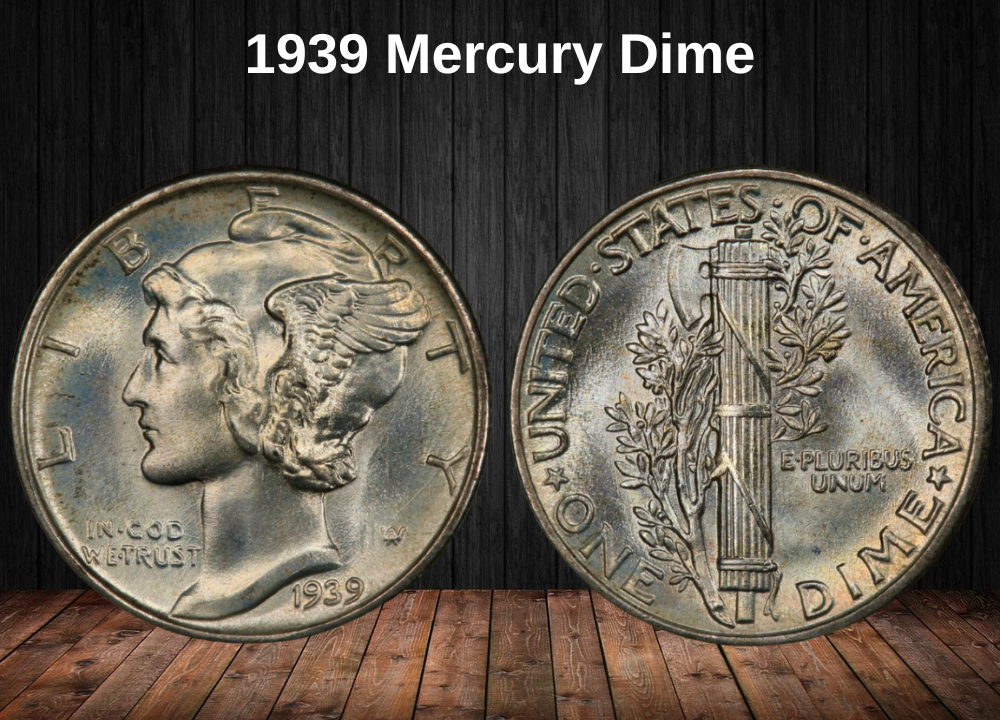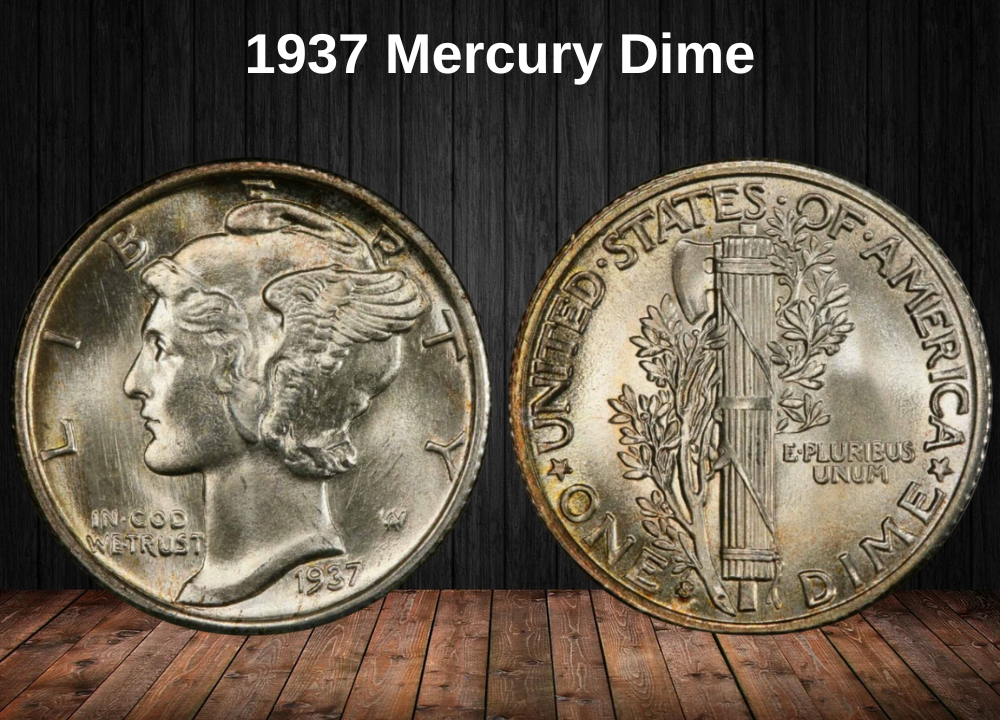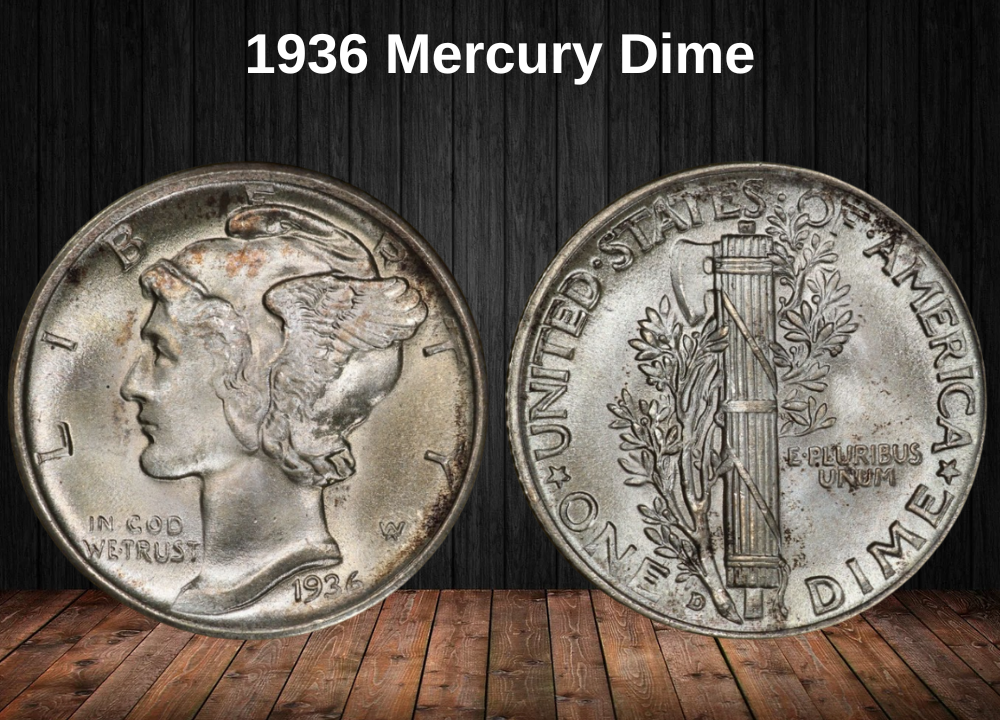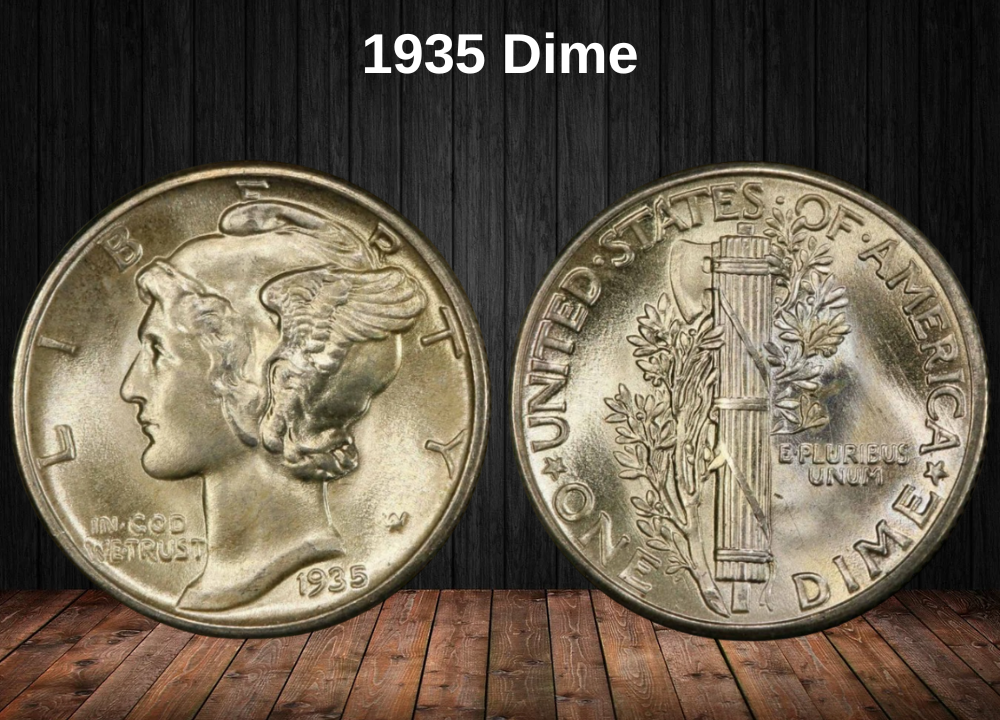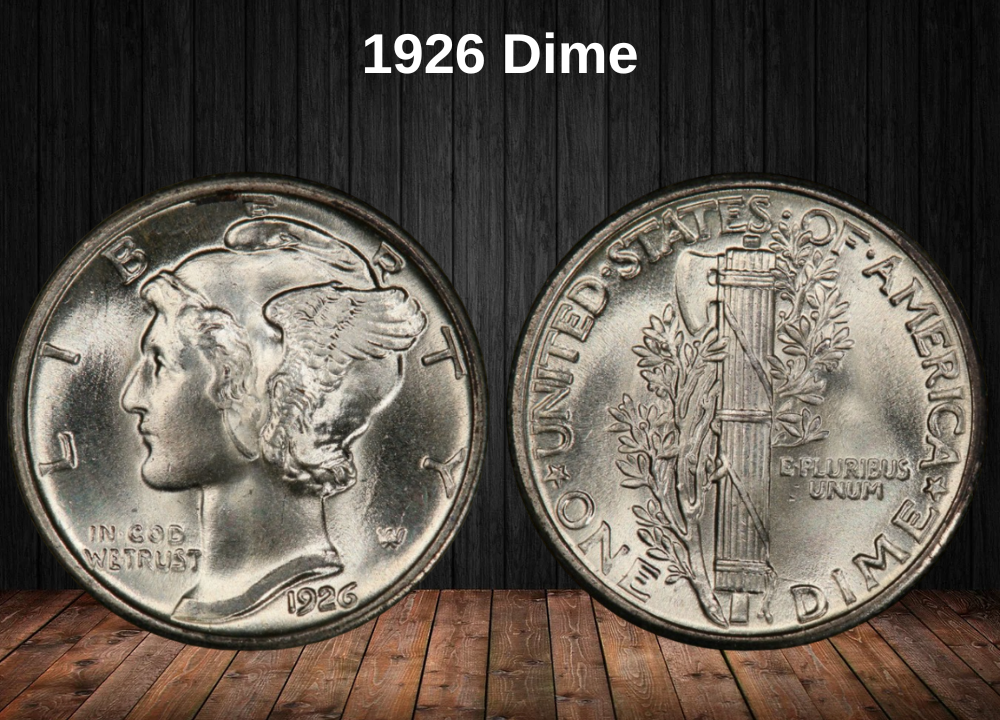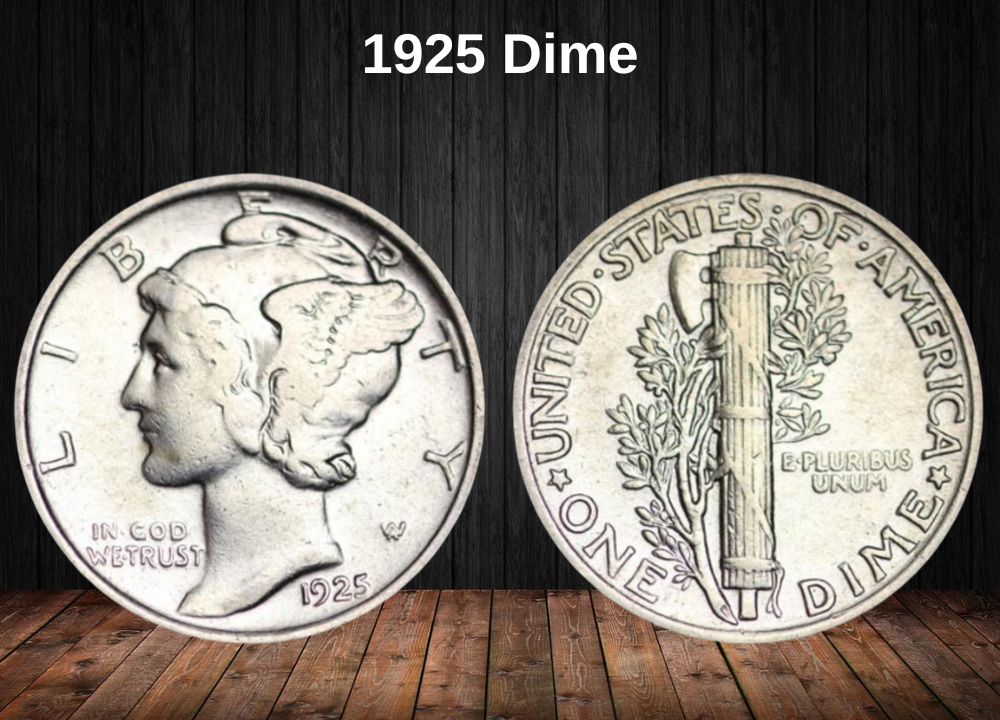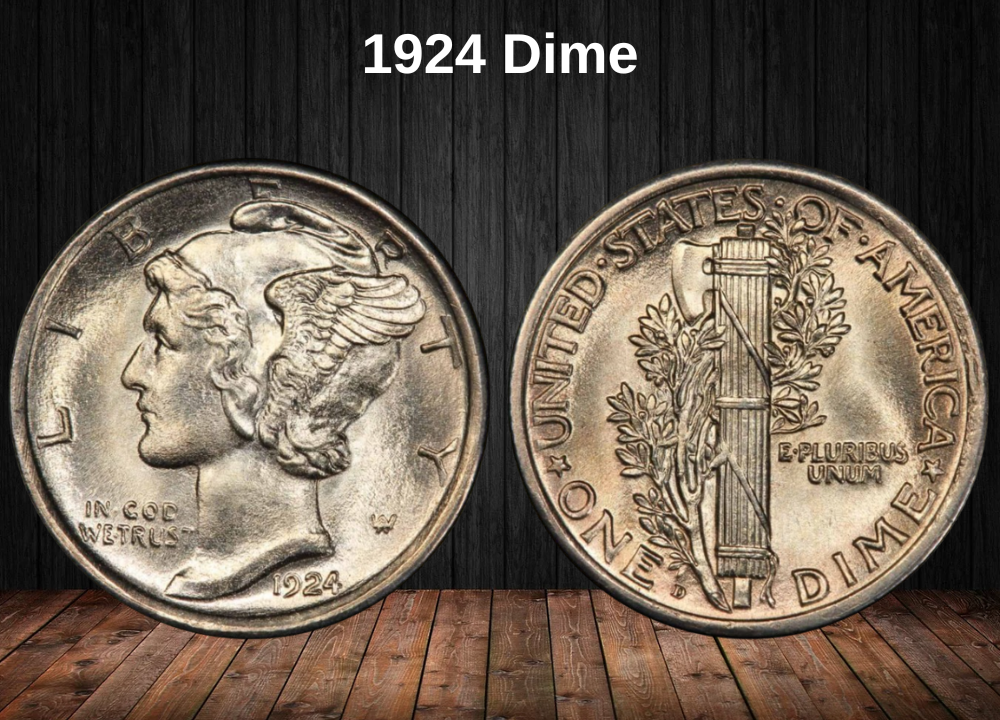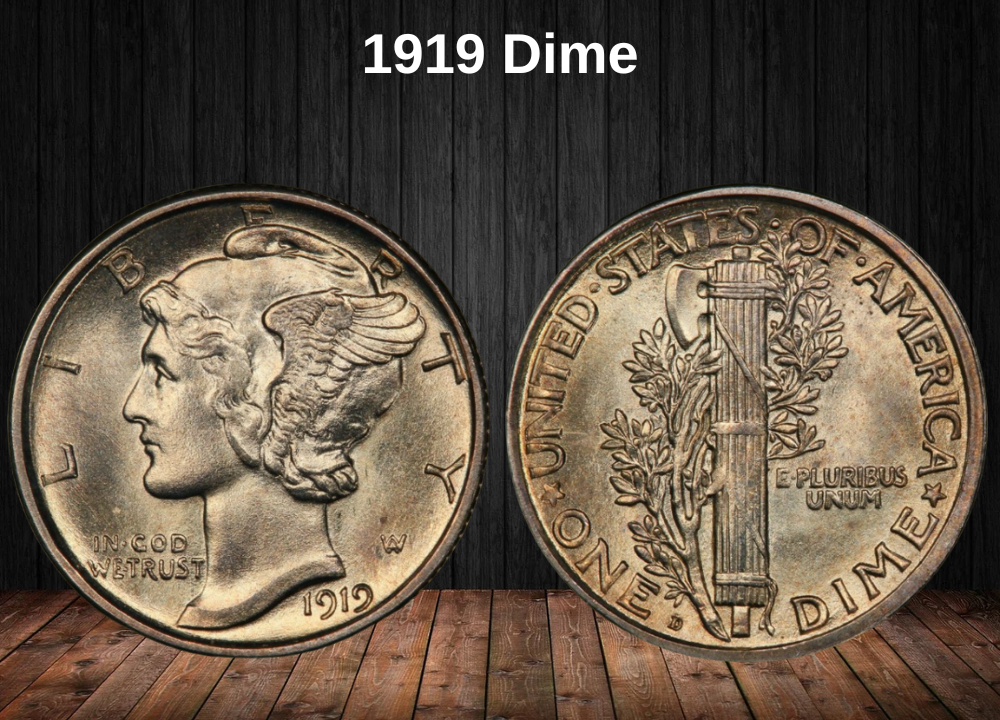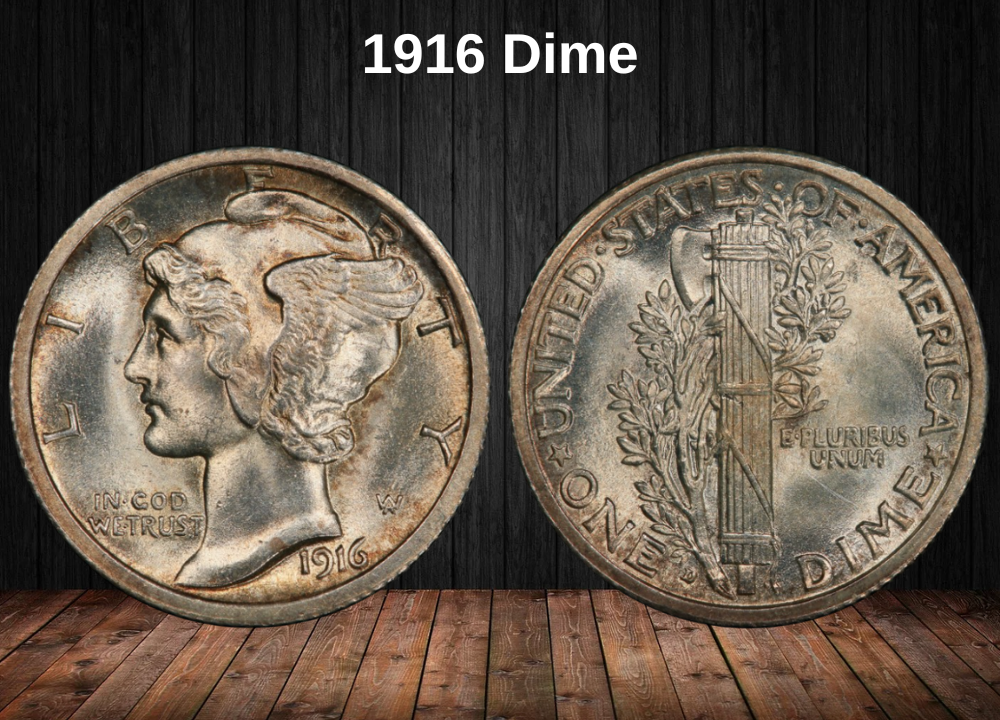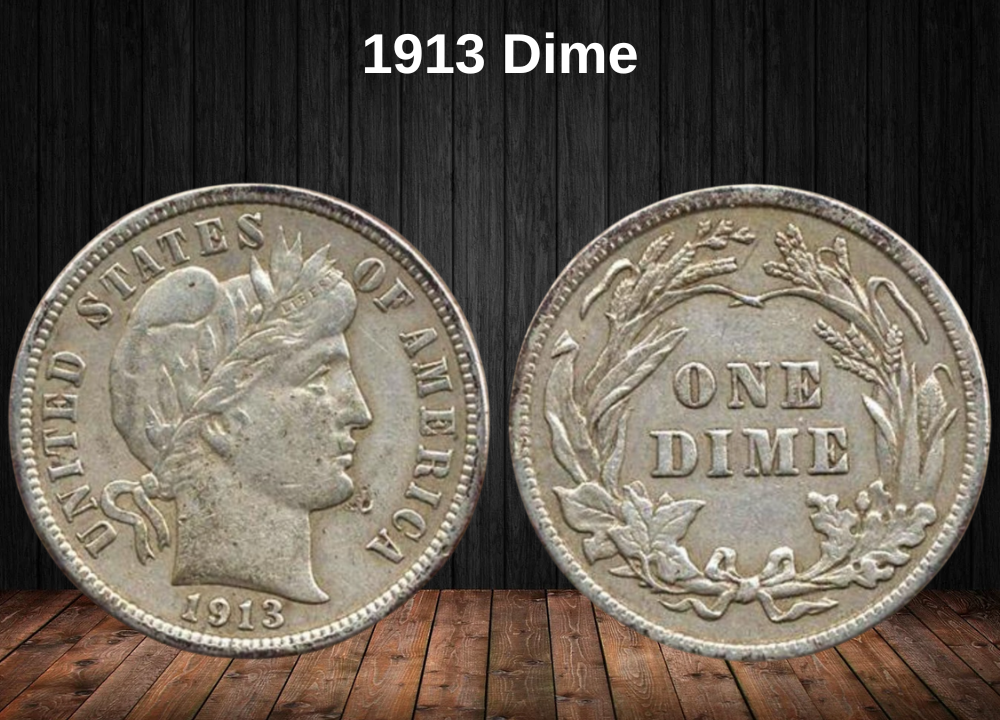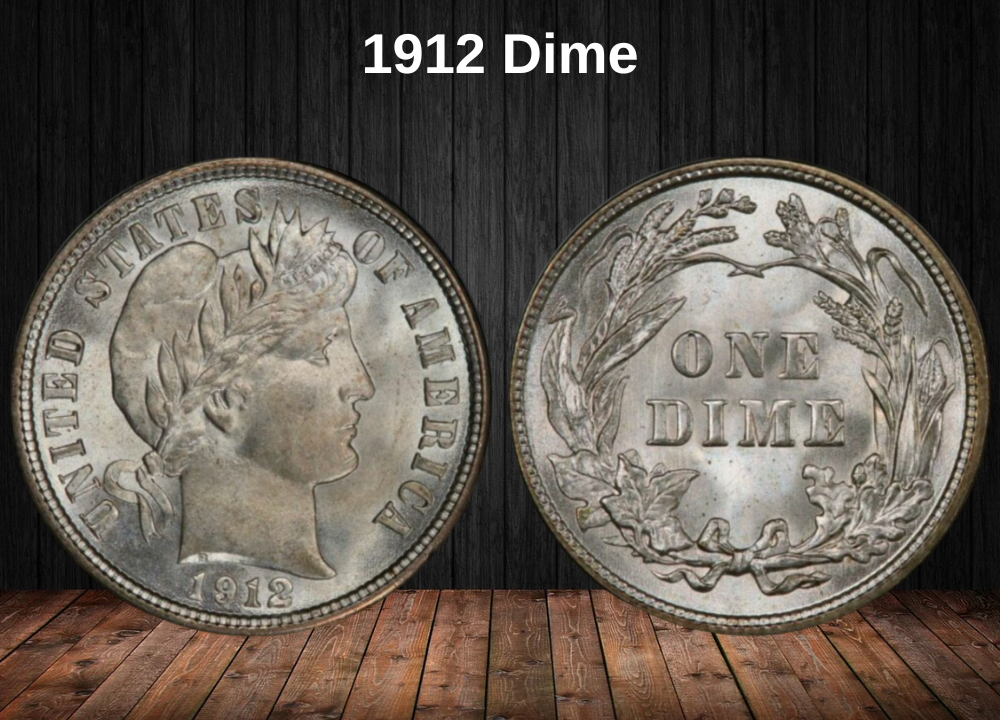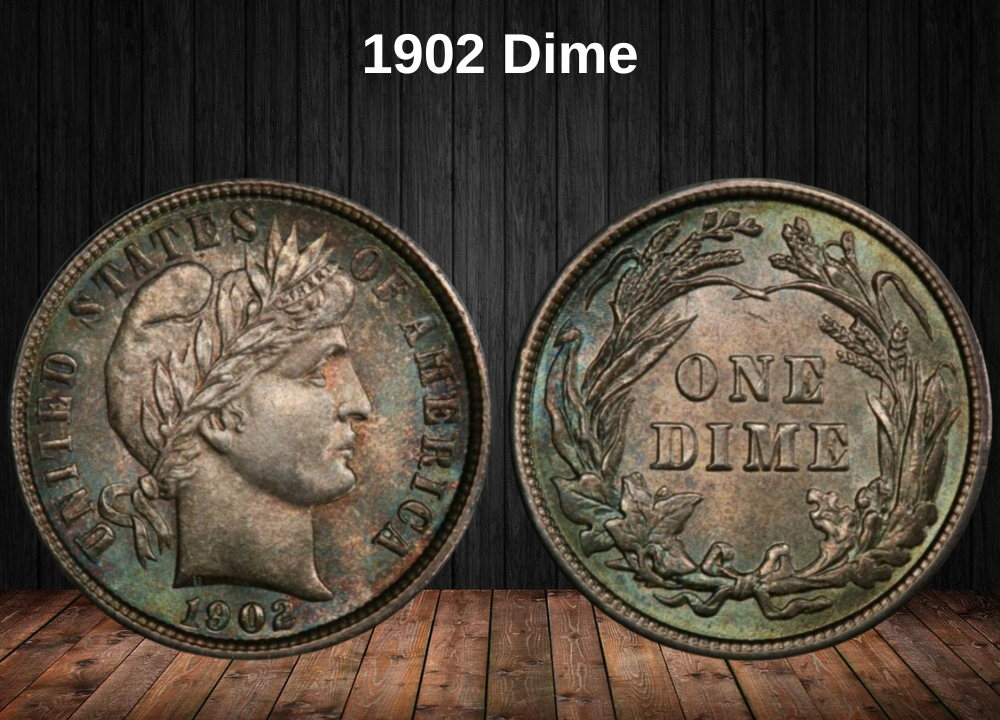The 1965 Roosevelt dime represents a turning point in U.S. coinage history. After nearly two decades of being struck in 90% silver (1946–1964), the Roosevelt dime transitioned in 1965 to a copper-nickel clad composition. This was a direct response to rising silver prices, which made it too costly for the U.S. Mint to continue producing circulating coins in precious metal.
In total, the Mint produced 1,654,500,570 dimes that year, a massive mintage that ensured their survival in circulation for decades. While most 1965 dimes remain common and only worth face value, certain varieties—especially Special Mint Set (SMS) coins and rare errors—carry significant collector premiums.
1965 Dime Value Chart
| Condition | 1965 Dime Value |
|---|---|
| MS60 | $2 |
| MS63 | $4 |
| MS65 | $12 |
| MS67 | $100+ |
Note: Values vary depending on strike quality. Coins with Full Bands (FB)—a sharp strike on the torch bands—are far scarcer and command higher premiums.
History of the 1965 Roosevelt Dime
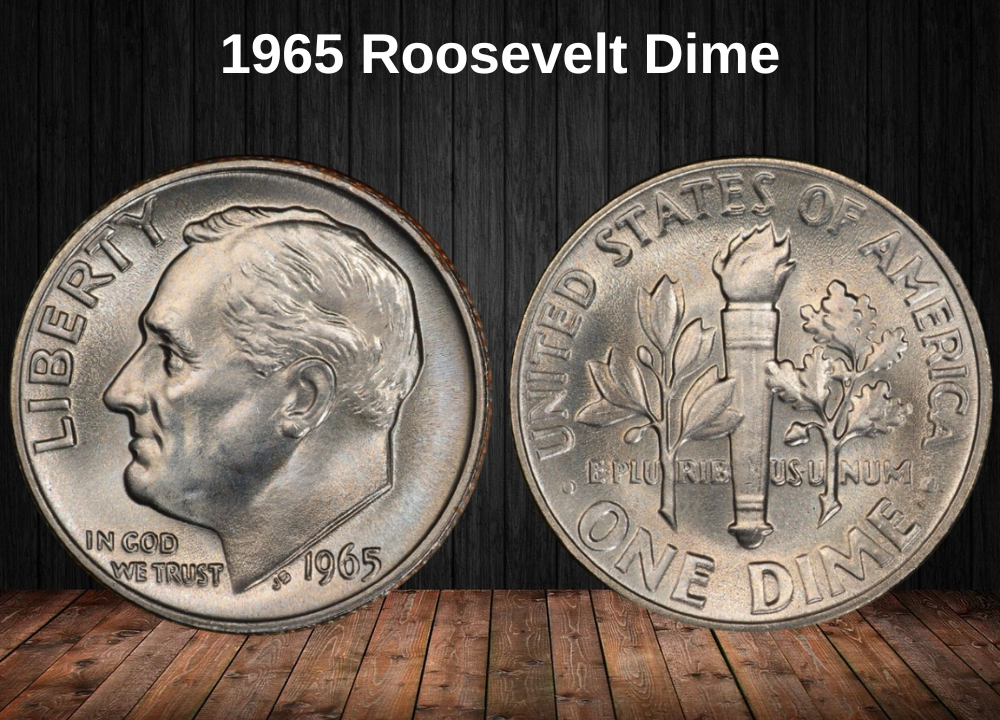
The 1965 Roosevelt dime holds a unique place in American numismatic history, not only as the continuation of the Roosevelt series but also as the first year the coin was struck without silver content. To fully appreciate its importance, we must look back at the dime’s lineage and the circumstances that led to the dramatic change in composition.
From the First “Disme” to the Roosevelt Dime
The dime, originally spelled “disme” when authorized by the Coinage Act of 1792, has undergone several transformations throughout U.S. history. Before the Roosevelt design, five major types defined the series:
- Draped Bust (1796–1807) and Capped Bust (1809–1837) dimes
- Seated Liberty dimes (1837–1891)
- Barber dimes (1892–1916)
- Mercury or Winged Liberty Head dimes (1916–1945)
After President Franklin Delano Roosevelt’s death on April 12, 1945, the nation honored him by placing his portrait on the dime in 1946. This was especially fitting because Roosevelt was a symbol of wartime leadership and the founder of the March of Dimes, which raised funds to fight polio—the disease he himself battled throughout his life.
The new dime was designed by Chief Engraver John R. Sinnock, whose initials “JS” appear on the obverse. During the early Cold War years, rumors circulated that these letters were a hidden tribute to Joseph Stalin, sparking controversy. Officials denied the claim, but suspicion persisted among some Americans, illustrating the tense political climate of the era.
The Shift from Silver to Copper-Nickel
For nearly two decades (1946–1964), Roosevelt dimes were struck in 90% silver and 10% copper. However, by the early 1960s, silver prices were climbing rapidly. As the public realized that the silver in their dimes, quarters, and half dollars was worth more than face value, massive hoarding began. This drained coins from circulation and threatened the nation’s coin supply.
The government’s solution came with the Coinage Act of 1965, which eliminated silver from the dime and quarter entirely. Beginning that year, Roosevelt dimes were struck with a copper-nickel clad composition: a pure copper core sandwiched between layers of copper-nickel alloy.
This marked the first time in U.S. history that the dime contained no precious metal.
1965 Roosevelt Dime Types and Mintages
| Location | Variety | Mintage |
|---|---|---|
| Philadelphia | 1965 No Mint Mark Dime | 1,652,140,570 |
| Philadelphia | 1965 Special Mint Set | 2,360,000 |
| Total | 1,654,500,570 |
No mint marks appeared on U.S. coins between 1965 and 1967—a deliberate move by the Mint to discourage further hoarding. Both circulation and Special Mint Set (SMS) dimes from 1965 therefore carry no mintmark.
The Economic Significance
The introduction of copper-clad dimes in 1965 was not simply a technical change but a reflection of America’s economic priorities in the post–World War II era. By eliminating silver from small change, the U.S. Mint ensured that coins would stay in circulation rather than vanish into vaults and drawers.
This transition preserved the stability of the coinage system and marked the beginning of modern American “clad coinage.” The 1965 Roosevelt dime thus stands as a symbol of economic adaptation and survival, while also remaining a favorite among collectors for its historic context and transitional varieties.
Features of the 1965 Roosevelt Dime
The 1965 Roosevelt dime was minted exclusively at the Philadelphia Mint in two variations: regular circulation strikes and coins included in the Special Mint Sets (SMS), which were packaged with four other denominations for collectors.
As the first year the dime was struck without silver content, the 1965 issue is historically significant and a true transitional piece. While the composition changed, the overall design by John R. Sinnock remained faithful to the style introduced in 1946.
Obverse Design
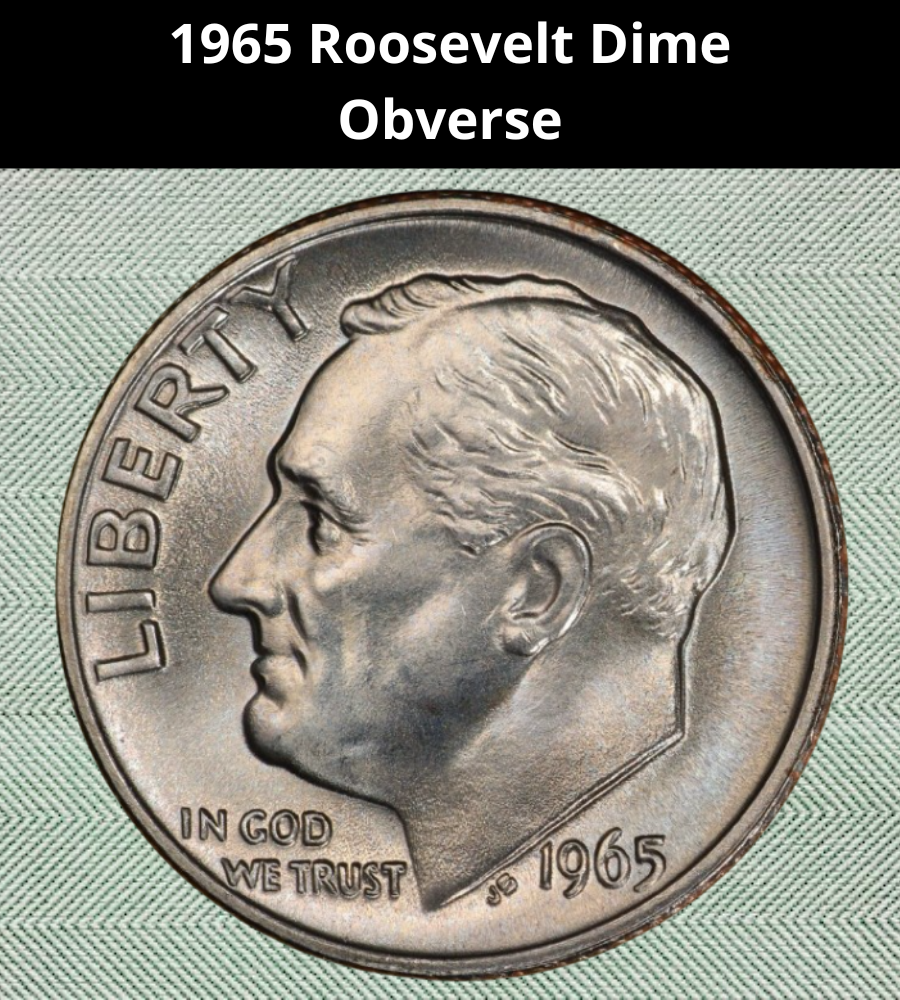
The obverse features the dignified bust of President Franklin Delano Roosevelt, honoring his leadership during World War II and his role in founding the March of Dimes.
- Designer’s Initials: “JS” (for John Sinnock) appear at the base of Roosevelt’s neck.
- Date: The year 1965 is placed to the right of the portrait in a slightly larger font.
- Legends:
- LIBERTY arcs along the left rim, in front of Roosevelt’s profile.
- IN GOD WE TRUST is arranged in two lines beneath the chin.
- The placement is compact, with some letters of IN GOD WE TRUST gently touching the coin’s inner rim.
Reverse Design
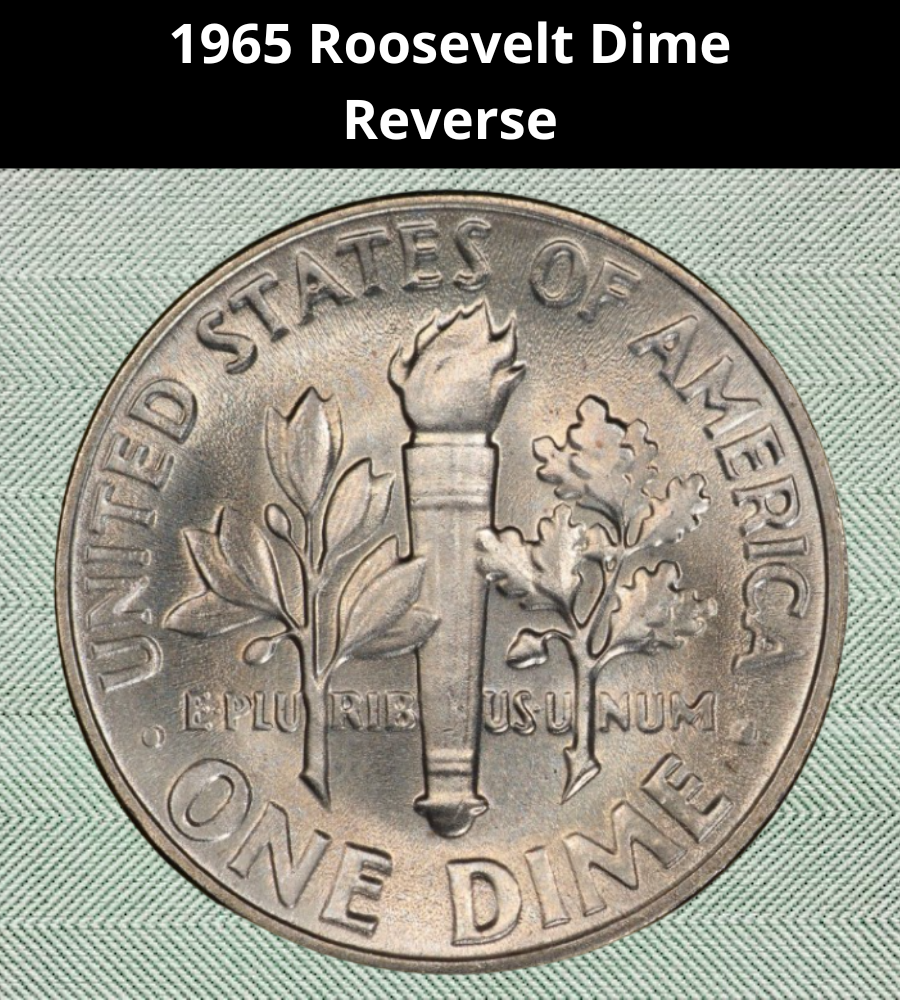
The reverse maintains the symbolic composition that has defined Roosevelt dimes since 1946:
- Torch of Liberty: Centered, with sharply defined flame, vertical grooves, and the distinctive horizontal bands.
- Olive Branch (left): Symbolizing peace.
- Oak Branch (right): Representing strength and independence.
- Legends:
- UNITED STATES OF AMERICA arcs across the upper rim.
- E PLURIBUS UNUM (“Out of Many, One”) sits to the right of the torch.
- ONE DIME anchors the lower rim as the denomination.
Unlike earlier years, the 1965 dimes bear no mint mark, as the Mint temporarily suspended mintmarks between 1965 and 1967 to discourage hoarding during the coinage transition.
Physical Characteristics of the 1965 Dime
| Feature | Details |
|---|---|
| Face Value | Ten Cents ($0.10) |
| Composition | 91.67% copper core, 8.33% nickel cladding |
| Weight | 2.27 g (0.0801 oz) |
| Diameter | 17.91 mm (0.705 in) |
| Thickness | 1.3 mm (0.051 in) |
| Shape | Round |
| Edge | Reeded, 118 reeds |
1965 Dime Grading
| # | Grade |
|---|---|
| 1 | Basal State-1 |
| 2 | Fair |
| 3 | Very Fair |
| 4, 5, 6 | Good |
| 7, 8, 10 | Very Good |
| 12, 15 | Fine |
| 20, 30 | Very Fine |
| 40 | Extremely Fine |
| 50 | About Uncirculated |
| 60 | Mint State |
| 65 | Mint State |
| 70 | Mint State |
1965 Roosevelt Dime Value Guides
The 1965 Roosevelt dime was struck exclusively at the Philadelphia Mint, with an enormous production of 1,654,500,570 pieces. This massive output was essential to replace the millions of silver dimes being withdrawn and hoarded by the public.
Alongside regular circulation strikes, the Mint also prepared coins specifically for collectors, packaged in the newly introduced Special Mint Sets (SMS). These two categories—regular strikes and SMS issues—form the foundation of collecting for this transitional year.
1965 No Mint Mark Dime Value
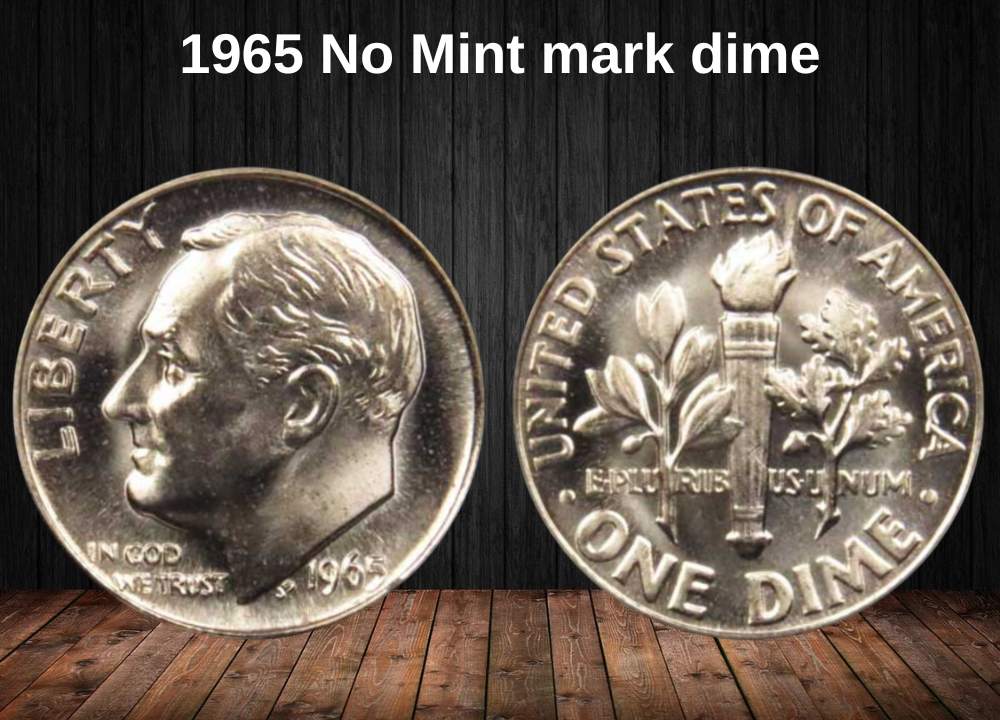
A staggering 1,652,140,570 regular strike dimes came from Philadelphia in 1965. None bear a mintmark, as mintmarks were temporarily suspended from 1965–1967 to discourage hoarding.
Most of these coins remain common today. Circulated examples are worth only their face value (10¢), but uncirculated specimens are considerably more collectible:
- MS60–MS62: $4
- MS63: ~$5
- MS64: ~$6
- MS65: ~$12
- MS66: ~$24
- MS67: ~$40
- MS68: Rare, around $750
👉 Collector’s note: While common in lower grades, true gems in MS68 are scarce and command high premiums.
1965 Dime with Full Bands (FB) Value
The most desirable circulation strikes from 1965 are those designated Full Bands (FB). This refers to the two horizontal bands at the top and bottom of the torch on the reverse, which, when fully struck, show clear and complete separation.
Because most 1965 dimes were weakly struck, Full Bands examples are much harder to find, and their values reflect this scarcity:
- MS65 FB: ~$55
- MS66 FB: ~$135
- MS67 FB: ~$1,000
- MS68 FB: $4,000+
In fact, the most expensive 1965 FB dime ever sold was an MS68 Full Bands, auctioned on eBay in July 2018 for $4,000.
1965 SMS Dime Value
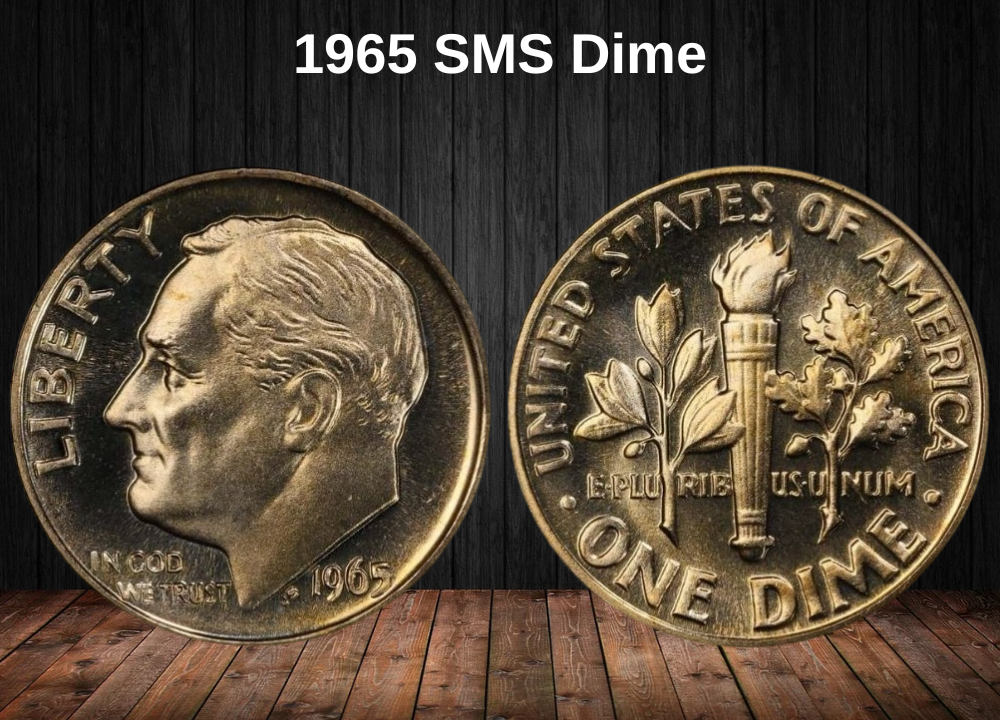
In addition to business strikes, the Philadelphia Mint produced 2,360,000 Special Mint Set (SMS) dimes in 1965. These coins were struck with greater care, featuring sharper details and a satin-like finish, making them highly attractive to collectors.
Values by grade are as follows:
- MS63: ~$5
- MS64: ~$6
- MS65: ~$8
- MS66: ~$14
- MS67: ~$18
- MS68: ~$32
- MS69: ~$500
1965 SMS Cameo and Deep Cameo Dimes
Some SMS dimes display Cameo (CAM) contrast, with frosted devices and mirrored fields. These bring strong premiums:
- MS63–MS66 CAM: $10–$85
- MS67 CAM: ~$185
- MS68 CAM: ~$2,750
The rarest are the Deep Cameo (DCAM) examples, which show dramatic frosting and deep mirror contrast. A 1965 SMS dime with Deep Cameo in MS67 is worth at least $200, with higher-grade pieces reaching much more.
Rare 1965 Dime Error List
The year 1965 marked a major transition in U.S. coinage, as the Mint shifted from 90% silver dimes to copper-nickel clad coinage. Unsurprisingly, this change in production brought with it a variety of minting errors and transitional mistakes. Today, these imperfections are among the most collectible—and often the most valuable—1965 Roosevelt dimes you can find.
Transitional Off-Metal Error
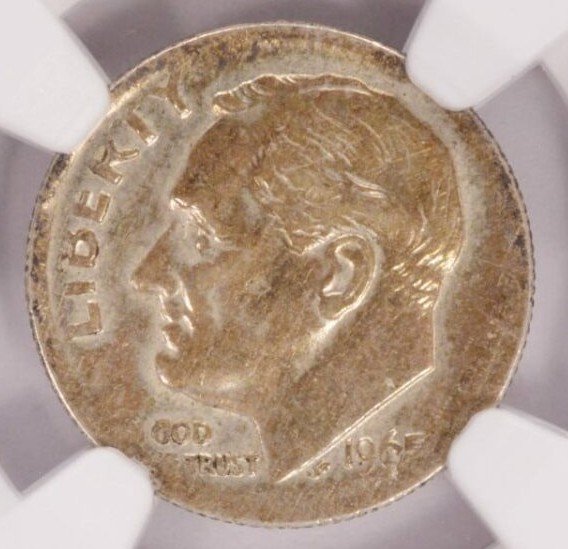
Perhaps the most dramatic error of 1965 is the transitional off-metal strike. These are dimes dated 1965 but struck on leftover 1964 silver planchets.
- Easy to spot: these weigh 2.5 grams (like silver dimes) instead of the clad standard of 2.27 grams.
- Because of their rarity, prices typically range from $3,000 to $6,000, depending on grade.
- Some exceptional specimens have sold for even more at major auctions.
👉 Collector’s note: Transitional errors are considered “holy grails” of modern coinage. Any 1965 dime found on a silver planchet should be authenticated immediately by PCGS or NGC.
Broad Strike
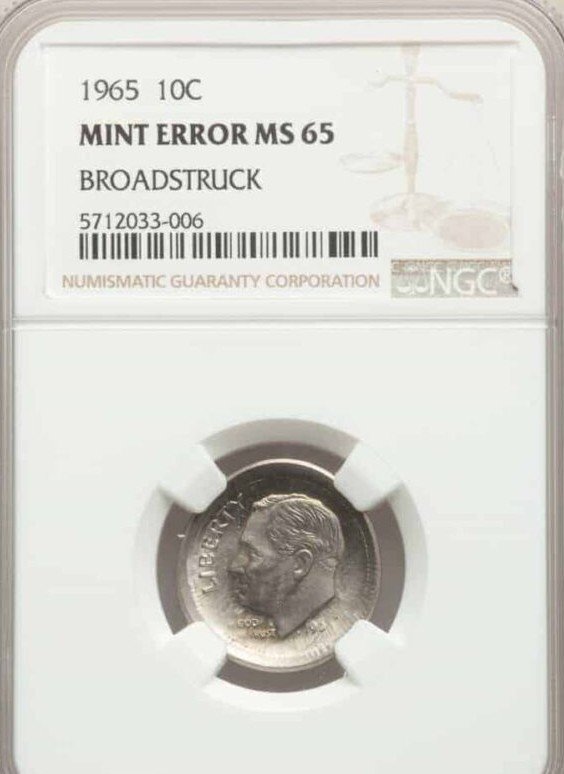
A broad strike error occurs when a coin is struck outside the collar that normally contains its shape. The result is a dime with no proper rim, often larger in diameter, while the design remains intact.
- Value in MS65 condition: Around $80.
- Eye-catching and obvious, broad strikes are popular with collectors of error coinage.
Die Break
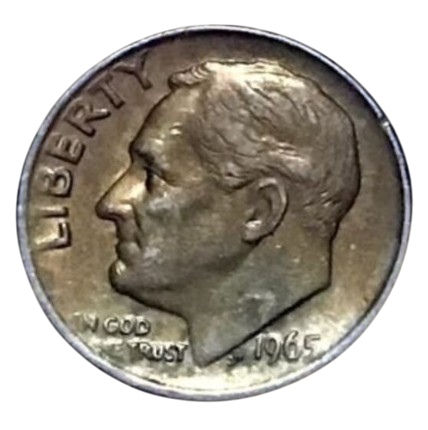
Overuse of dies during this high-mintage year sometimes caused parts of the die to break off. This produced coins with raised lumps, flat areas, or missing details on the obverse or reverse.
- Value: Around $20 in MS65 condition.
- Larger die breaks (also called “cuds”) can fetch higher premiums, especially if they are dramatic.
Clad Layer Error
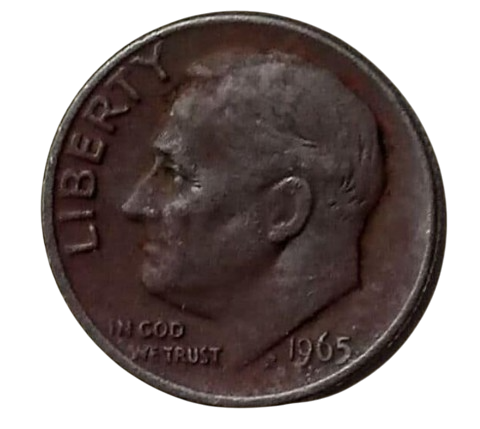
The 1965 dime introduced a copper-nickel clad construction, and some coins were struck without the proper cladding on one side.
- One side appears the usual silvery gray, while the other reveals a reddish tone from the exposed copper core.
- These coins are also lighter—about 15% less weight than normal.
- Value: Up to $90, depending on condition and eye appeal.
👉 Collector’s note: Partial clad errors are especially interesting in 1965 because it was the very first year the Mint experimented with the clad composition.
Where to Sell Your Dime Coin?
Now that you know the value of your dime, the next step is deciding where to sell it. There are several trusted options—both online and in person—that can help you get the best price depending on your coin’s rarity and condition.
To see the full list of recommended places, along with their advantages and disadvantages, check our complete guide on where to sell your dime coins.
FAQ about the 1965 Roosevelt Dime
1. Why is the 1965 Roosevelt dime considered historically important?
The 1965 dime marks the first year of clad coinage for the denomination, ending nearly two decades of 90% silver Roosevelt dimes. It represents the U.S. Mint’s response to rising silver prices and massive hoarding, making it a pivotal transitional coin in modern American numismatics.
2. How can I tell if my 1965 dime is silver or clad?
Most 1965 dimes are clad, with a copper core visible along the edge. However, a small number of transitional errors exist—these were struck on leftover 90% silver planchets. Silver 1965 dimes weigh 2.5 grams, while clad versions weigh 2.27 grams. A scale and edge inspection are the fastest ways to check.
3. Why do 1965 dimes have no mint mark?
From 1965 to 1967, the U.S. Mint suspended mint marks on all coins to discourage collectors from hoarding by mint location. As a result, all 1965 Roosevelt dimes—whether circulation or SMS (Special Mint Set)—appear without a mintmark.
4. What are Full Bands on a 1965 dime?
“Full Bands (FB)” refers to the sharp separation of the two horizontal bands at the top and bottom of the torch on the reverse. Because many 1965 dimes were weakly struck, well-defined Full Bands are scarce and command high premiums, with top-grade examples reaching thousands of dollars at auction.
5. What makes the 1965 SMS dime different from circulation strikes?
The Special Mint Set (SMS) coins were struck with extra care, using polished dies and higher pressure. They feature a satin-like finish, sharper details, and often Cameo or Deep Cameo contrast. With a mintage of 2,360,000, SMS dimes are common in lower grades but rare in high-grade Deep Cameo, where values can exceed $2,000.
6. What are the most valuable 1965 dime errors?
The standout error is the transitional silver dime, worth $3,000–$6,000 or more. Other collectible errors include:
- Broad strikes (around $80)
- Clad layer missing (up to $90)
- Dramatic die breaks (varies by size and visibility)
Error collectors especially prize 1965 because of the unusual production issues caused by the transition from silver to clad coinage.
7. Is it worth saving circulated 1965 dimes?
Most circulated 1965 dimes are only worth face value (10¢), since they contain no silver. However, it is always wise to check for:
- Transitional silver planchet strikes
- Full Bands designations in higher grades
- Special Mint Set Cameo or Deep Cameo examples
These rarities can turn a common-looking dime into a highly valuable collectible.


